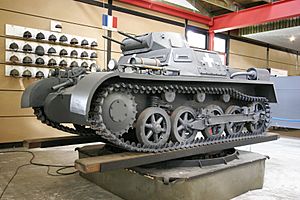Panzer I facts for kids
Quick facts for kids Panzerkampfwagen I |
|
|---|---|

A Panzerkampfwagen I Ausf. A being displayed at the Deutsches Panzermuseum Munster in Germany
|
|
| Type | Light tank |
| Place of origin | |
| Service history | |
| In service | 1934–1945 in Nazi Germany |
| Used by | Nazi Germany, Bulgaria, Republic of China, Hungary, Spain |
| Wars | Spanish Civil War Second World War Second Sino-Japanese War |
| Production history | |
| Designed | 1934 |
| Manufacturer | Henschel, MAN, Krupp, Daimler |
| Produced | 1934–1937 |
| No. built | 1493 |
| Specifications | |
| Mass | 5.4 tonnes (6.0 short tons) |
| Length | 4.02 m (13.2 ft) |
| Width | 2.06 m (6.8 ft) |
| Height | 1.72 m (5.6 ft) |
| Crew | 2 (commander and driver) |
|
|
|
| Armor | 7–13 mm |
|
Main
armament |
2 × 7.92 mm MG13 machine guns |
| Engine | Krupp M 305 four-cylinder air-cooled gasoline engine 60 PS (59 hp, 44 kW) |
| Power/weight | 11.1 PS/t |
| Suspension | leaf quarter-elliptic springs |
|
Operational
range |
On-road: 200 km (120 mi) Off-road: 175 km (109 mi) |
| Maximum speed | On-road: 50 km/h (31 mph) Off-road: 37 km/h (23 mph) |
The Panzer I was a small, light tank used by Nazi Germany in the 1930s and during World War II. Its full name was Panzerkampfwagen I, which means "armored fighting vehicle mark I". It was often shortened to PzKpfw I.
This tank was mainly designed to train soldiers in armoured warfare, which is fighting with tanks. It was not meant to be a main battle tank. However, it was used in real combat in several wars. These included the Spanish Civil War, the invasion of Poland, the Battle of France, and battles in the Soviet Union and North Africa during the Second World War. It also saw action in China during the Second Sino-Japanese War.
Contents
Design and Features
The Panzer I was built between 1934 and 1937. It was a very light tank, weighing about 5.4 tons. It had thin armor, only 7 to 13 millimeters thick. This meant it could not withstand many enemy attacks.
Armament and Crew
The tank was armed with two 7.92 mm MG13 machine guns. These guns were good for fighting infantry (soldiers on foot) but not strong enough to damage other tanks. The Panzer I had a crew of two people: a commander and a driver.
Engine and Speed
The Panzer I was powered by a Krupp M 305 four-cylinder gasoline engine. This engine gave it 60 horsepower. On roads, the tank could reach speeds of up to 50 kilometers per hour (about 31 miles per hour). Off-road, it was slower, moving at about 37 kilometers per hour (about 23 miles per hour). It could travel about 200 kilometers (124 miles) on roads before needing more fuel.
Role in Wars
Even though the Panzer I was designed for training, it played a big part in Germany's early tank forces. This was because Germany did not have many other tanks at the time.
Spanish Civil War
The Panzer I first saw combat in the Spanish Civil War (1936-1939). Germany sent these tanks to support one side in the conflict. Here, it faced tanks from the Soviet Union, which were often better armed and armored. The Panzer I's weaknesses became clear during these battles.
World War II and Beyond
When World War II began in 1939, the Panzer I was still a major part of the German tank force. It was used in the invasion of Poland and France. However, as the war continued, Germany developed stronger tanks like the Panzer IV, Panther, and Tiger. These new tanks had much thicker armor and more powerful guns. Because of this, the Panzer I was slowly replaced and used less in front-line combat. Some were converted into other types of vehicles or used for training.
Images for kids
-
A Panzer I Ausf. B on the streets of Calais, France, in May 1940, while rounding up British prisoners-of-war following the defeat of France by Nazi Germany in that same year
See also
 In Spanish: Panzer I para niños
In Spanish: Panzer I para niños









